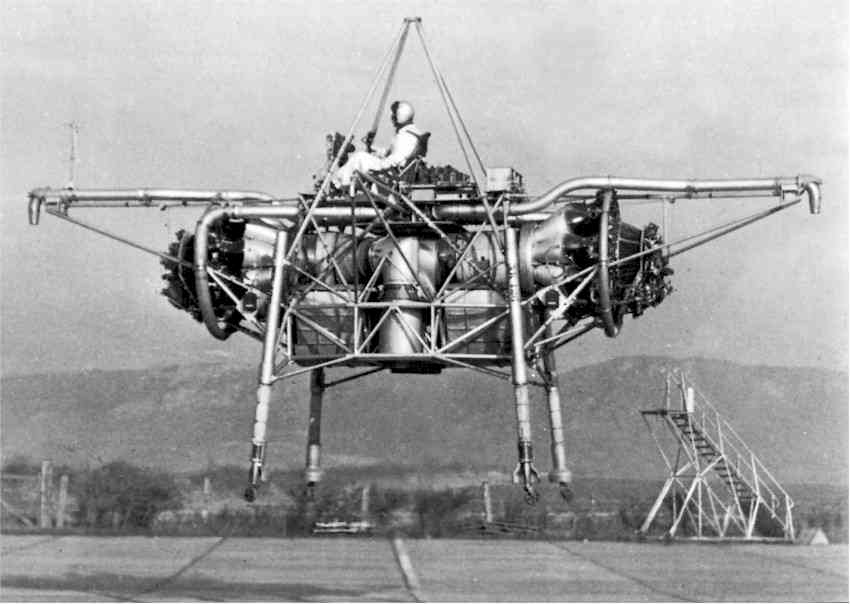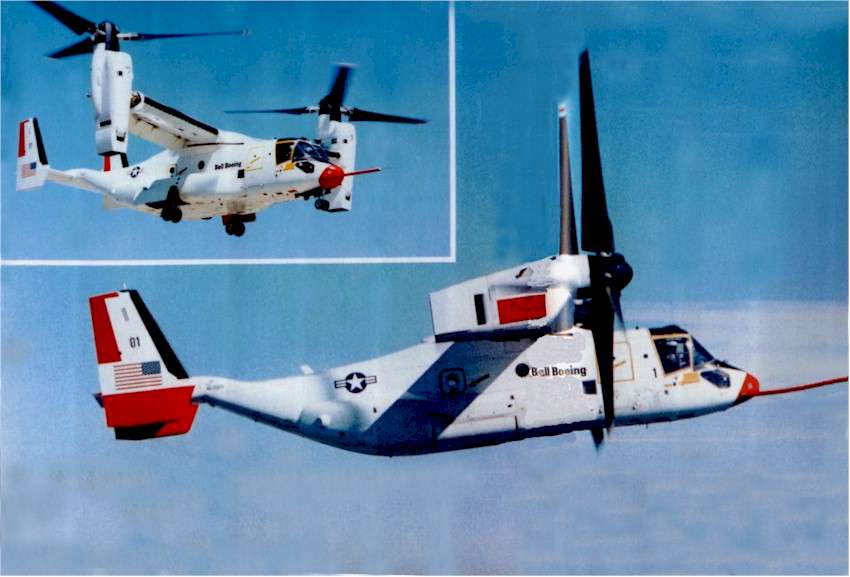Flying Beds and Metal Birds
Rolls-Royce Flying BedsteadWe do not consider that aeroplanes will be of any possible use for war purposes. - The British Secretary of State for War, 1910 Aeroplanes are interesting toys but of no military value. - Marshall Ferdinand Foch, professor of strategy, Ecole Superiure de Guerre 1911
Rolls-Royce's Thrust-measuring Rig was nicknamed the "Flying Bedstead." It was first flown in August 1954 to help in the development of VTOL aircraft. The jetpipes of the two Nene engines were downward turned by 90o to give vertical thrust. Rolls-Royce in Britain, Dornier in Germany and others found that constructing open-structure hovering test rigs was a useful first step in understanding the problems associated with the flight, stability and control of jet-powered vertical take-off aircraft. Source: The World's Strangest Aircraft: A Collection of Weird and Wonderful Flying Machines by Michael Taylor
Bell-Boeing V-22 OspreyThe only time an aircraft has too much fuel on board is when it's on fire. - Sir Charles Kingsford Smith, sometime before his death in the 1920s
The complete propulsion assembly is able to tilt through 97.5o. Maximum troop accommodation is 24. In 1989, prop rotor technology reappeared in potentially its most useful form, as a joint effort by Bell and Boeing and known as the V-22 Osprey, which made its maiden flight on 19 March. As a twin turboshaft tilt-rotor type of larger size than the XV-15, it is the first such aircraft expected to achieve mass production, and is scheduled for initial operational capability with the US military forces from the year 2001. Various roles are planned including troop and cargo transportation, assault, medical evacuation, combat search and rescue, and special operations. The prop rotors are each 38 feet (11.6 m) in diameter driven by two 6,150 shaft hp Allison T406-AD-400 turboshaft engines. Finally revealing the full potential of convertiplanes, Osprey can take-off and land as a helicopter, yet attain 361 miles per hour (581km/h) in aeroplane flight mode and still carry a 20,000-pound (9,072-kg) load for well over 2,000 miles (3,218km). Source: The World's Strangest Aircraft: A Collection of Weird and Wonderful Flying Machines by Michael Taylor
Marines Turn Osprey Investigation over to PentagonWashington - Under pressure from Congress for an independent investigation, the Marine Corps on Wednesday turned over its investigation of falsified maintenance records for the controversial MV-22 Osprey program to the Pentagon's inspector general. The announcement follows a call by leaders of the Senate Armed Services Committee for an outside review of allegations that a Marine Corps MV-22 squadron commander ordered maintenance records altered to make the troubled MV-22 appear more reliable than it really is. A statement by Marine Corps Commandant General James Jones said, "While I have complete confidence that the Marine Corps IG and his staff would conduct a thorough, complete, and unbiased investigation into these allegations, I am concerned that the nature and gravity of the allegations may invite unwarranted perceptions of command influence or institutional bias. Further, in so much as the MV-22 program affects other services, I also believe we would benefit from an inquiry by an independent investigative branch such as the DoD IG." The commander of the Marine Corps' only MV-22 squadron, Lieutenant Colonel Odin Fred Leberman, has admitted to his superiors that he asked for maintenance records to be falsified to make the reliability of the controversial aircraft look better than it really is, a senior Marine official told CNN last week. The official, speaking on condition of anonymity, said that Leberman admitted under questioning from his immediate superior that the allegations against him were true. On 12 January, the Secretary of the Navy received an anonymous letter and audio tape from someone claiming to be a mechanic in the squadron. The letter leveled charges against Leberman, who can be heard on the tape saying, "The reason we need to lie or manipulate the data or however you want to call it, is that this program is in jeopardy." Leberman was relieved of his command of the Marine Medium Tilt-rotor Helicopter Training Squadron 204, Marine Corps Air Station New River, North Carolina, and faces possible criminal charges. Marine Corps officials insist the allegations, even if true, had nothing to do with the two MV-22 accidents crashes last year, one in April and one in December. The first crash was caused by pilot error, and the second by a hydraulic failure compounded by software problems. A Pentagon report released last month faulted the MV-22 Osprey for its high maintenance and low reliability, a criticism which prompted the Navy to delay final approval of the $40 billion program. In the anonymous letter, the mechanic, who claims to have worked on the Osprey for two years, wrote, "This plane is not ready for the fleet. This might be a great plane one day, but not today." The decision to turn over the investigation to the Pentagon's inspector general was approved by acting Navy Secretary Robin Pirie Jr and Defense Secretary Donald Rumsfeld. CNN Military Affairs Correspondent Jamie McIntyre contributed to this report Source: CNN 25 January - 1 February 2001
Osprey Is a Bad Birdby Jeremy Bratt Washington, DC - After suffering two tragic accidents last year that claimed the lives of 23 soldiers, the Marine Corps' vaunted MV-22 Osprey program has again come under fire. Federal investigators raided the North Carolina headquarters of the only Osprey squadron last Thursday, relieving the commander, who has been charged with falsifying maintenance records in an effort to aid the troubled program as it moved toward full-scale production. The V-22 Osprey - which is built in Ridley Park - has always been of questionable military value, but its strong congressional backing made it the Teflon weapon - no criticism could stick. But with last week's arrest, that political cover appears to be wearing off. There is now a chance for this ill-conceived program to finally come to an end, and the Bush Administration should seize it. The V-22, a troop transporter that takes off like a helicopter and flies like a plane, was designed to carry out amphibious assaults, a fairly limited job description in this day and age. But that hasn't stopped the Marine Corps from budgeting more than $36 billion for this boondoggle of a weapon. That's money that could be put to better use by giving the military's servicemen and women a pay raise, or even - dare I suggest it? - investing it domestically in public education or health care. But providing quality health care doesn't help a seven-term Congressman like Pennsylvania's Curt Weldon - in whose district the Osprey is built - rake in campaign contributions from the defense industry, which contributed $80,000 to him in the 2000 election cycle. By providing large infusions of campaign cash and vital manufacturing jobs in politically key states, the Boeing-produced V-22 has long enjoyed the support of powerful allies in Congress. During his tenure as Defense Secretary, Vice-President Cheney attempted to kill the Osprey, but the program was saved by Congress. Yet after nearly 15 years of research and development, much of the plane's technology is not ready, as evidenced by a steadily growing pile of official reports documenting problems with the V-22. A 16 August 2000 report by the Inspector General of the Pentagon described 22 "major deficiencies" within the program. A 30 November 2000 report by Philip Coyle, the Pentagon's Director of Operational Testing and Evaluation, wrote that the Osprey's poor reliability record "suggests the V-22 would be available to conduct fewer missions, would abort during a mission more often and would pose a significantly increased maintenance burden - perhaps exceeding the existing maintenance manning of CH-46 squadrons. "Despite the Osprey's approximate price tag of $58 million a copy, it is less reliable than the 36-year-old model it is intended to replace." Official reports notwithstanding, there may be deadly consequences for troops who fly to the battlefield in the Osprey. Designed to fly faster and farther than any other troop transporter in the Marines' inventory, the lightly-armored V-22 relies on speed to survive. It cannot carry heavy equipment, so the troops on board can be armed only with light weapons; any heavy loads would slow the plane down and expose it to enemy fire. This will put the Marines at a serious disadvantage. While they are an extremely well-trained and deadly fighting force, Marines need heavy equipment - artillery and armored personnel vehicles, for instance - to hold off a well-armed enemy. In the event of a war, the Osprey will succeed only in dropping lightly-armed troops deep behind enemy lines, without the equipment they depend on, and out of the range of the traditional heavy-lifting helicopters that could supply them. It remains to be seen whether President Bush is up to the challenge of taking on the parochial interests in Congress by finally cancelling the V-22 Osprey. If he does, however, it will be a decision that is practical, fiscally prudent...and long overdue. Jeremy Bratt is a Herbert Scoville Jr Peace Fellow at the Council for a Livable World Education Fund in Washington, DC. If you would like to respond to this Slant or have one of your own (650 words), contact Howard Altman, City Paper news editor, 123 Chestnut Street, Philadelphia, Pennsylvania 19106 or e-mail altman@citypaper.net. Source: citypaper.net 25 January – 1 February 2001
To view other articles related to flying including history, unusual flying machines, hot air balloons, skydiving, gliding, problems,
airports, turbulence, pilots, crashes, the Paris Air Show, the future, blimps, space travel, solar sails and more, clicking the "Up" button
below takes you to the Table of Contents for this section on Flight. |
 Animals
Animals Animation
Animation Art of Playing Cards
Art of Playing Cards Drugs
Drugs Education
Education Environment
Environment Flying
Flying History
History Humour
Humour Immigration
Immigration Info/Tech
Info/Tech Intellectual/Entertaining
Intellectual/Entertaining Lifestyles
Lifestyles Men
Men Money/Politics/Law
Money/Politics/Law New Jersey
New Jersey Odds and Oddities
Odds and Oddities Older & Under
Older & Under Photography
Photography Prisons
Prisons Relationships
Relationships Science
Science Social/Cultural
Social/Cultural Terrorism
Terrorism Wellington
Wellington Working
Working Zero Return Investment
Zero Return Investment
